What is in this leaflet
This leaflet answers some common questions about KINERET. It does not contain all the available information. It does not take the place of talking to your health professional (i.e. doctor, nurse, pharmacist).
All medicines have risks and benefits. Your doctor has weighed the risks of you using KINERET against the benefits he/she expect it will have for you.
If you have any concerns about using this medicine, ask your health professional.
Read this leaflet carefully before you start using KINERET and keep it with the medicine. You may need to read it again.
What KINERET is used for
KINERET contains the active substance anakinra and is used to treat the signs and symptoms associated with:
- active Rheumatoid Arthritis (RA) in adults in combination with methotrexate;
- Cryopyrin-Associated Periodic Syndromes (CAPS), including Neonatal-Onset Multisystem Inflammatory Disease (NOMID) / Chronic Infantile Neurological, Cutaneous, Articular Syndrome (CINCA), Muckle-Wells Syndrome (MWS), and Familial Cold Autoinflammatory Syndrome (FCAS) in adults and children (aged 8 months and older);
- active Systemic Juvenile Idiopathic Arthritis (SJIA) in patients aged 2 years and above.
In people with RA, CAPS and SJIA, the body produces too much of the protein interleukin-1. Too much interleukin-1 causes inflammation contributing to the symptoms of the diseases. The body blocks this inflammation by producing an interleukin-1-receptor antagonist (IL-1Ra). In patients with RA, CAPS and SJIA, the amount of IL-1Ra that the body produces is not enough to counteract the increased amount of interleukin-1. KINERET, which contains anakinra (a man-made protein similar to IL-1Ra), can block the action of interleukin-1 and reduce the signs and symptoms of the disease.
The time it takes to see an improvement in symptoms varies from person to person; your doctor will monitor your response to KINERET.
In people with RA, KINERET is given in combination with methotrexate.
Ask your doctor if you have any questions about why this medicine has been prescribed for you. Your doctor may have prescribed it for another reason.
Before you use KINERET
When you must not use it
Do not use KINERET if you are using a medicine that is a tumour necrosis factor (TNF) antagonist. Ask your doctor or pharmacist if you are not sure whether you are taking such a medicine.
Do not use KINERET if you have an allergy to:
- any medicine containing anakinra
- any of the ingredients listed at the end of this leaflet
- any other medicines made using E. coli-derived proteins.
Some of the symptoms of an allergic reaction may include:
- shortness of breath
- wheezing or difficulty breathing
- swelling of the face, lips, tongue or other parts of the body
- rash, itching or hives on the skin.
Do not give this medicine to a child with RA or to a child younger than 8 months of age or body weight less than 10 kg with CAPS.
Do not give this medicine to a child younger than 2 years with SJIA.
Do not use this medicine after the expiry date printed on the pack or if the packaging is torn or shows signs of tampering. If it has expired or is damaged, return it to your pharmacist for disposal.
Do not use KINERET if the syringe has been left out of the refrigerator for more than 12 hours.
Do not use KINERET if the syringe has been dropped. This is for your safety in case the syringe is broken or the needle is bent or dirty.
KINERET is not recommended for use in patients with severe renal impairment.
KINERET is not recommended for use in patients with pre-existing malignancy.
KINERET should not be used in patients with neutropaenia (low white blood cell count).
If you are not sure whether you should start taking this medicine, talk to your health professional.
Before you start to use it
Tell your doctor if you have allergies to any other medicines, foods, preservatives or dyes.
Tell your doctor if you have or have had any of the following medical conditions:
- kidney disease
- cancer
- infections (ongoing or recent) or a history of frequent infections or any problems that increase your risk of infections
- diseases that affect your immune response
- asthma.
Tell your doctor about your vaccination history and if you have had a recent vaccination. Your doctor may ask you to complete all vaccinations before starting KINERET.
Tell your doctor if you have a history of increased levels of liver enzymes.
Tell your doctor if you are using any other medicines to treat your condition.
Tell your doctor if you are pregnant or plan to become pregnant or are breastfeeding. KINERET has not been tested in pregnant women. Use of KINERET is not recommended during pregnancy and adequate contraception must be used by women of childbearing potential when using KINERET.
You must not breastfeed if you use KINERET. It is not known whether KINERET passes into breast milk.
If you have not told your doctor about any of the above, tell him/her before you start using KINERET. Your doctor can discuss with you the risks and benefits involved.
Taking other medicines
Tell your doctor if you are taking warfarin or phenytoin. Your doctor may need to adjust the dose of your medication.
Tell your doctor or pharmacist if you are taking any other medicines, including any that you buy without a prescription from your pharmacy, supermarket or health food shop. Your doctor and pharmacist have more information on medicines to be careful with or avoid while taking this medicine.
How to use KINERET
KINERET is usually given by daily injection under your skin; this is called a subcutaneous injection.
Follow all directions given to you by your health professional carefully. They may differ from the information contained in this leaflet.
If you do not understand the instructions in this leaflet, ask your health professional for help. Your health professional will teach you or your carer how to give a subcutaneous injection so that KINERET can be administered at home once you or your carer are confident with the process.
If you are not sure about giving the injection or you have any questions, ask your doctor or nurse for help.
How much to use
Always use this medicine exactly as your doctor has told you.
Your doctor will decide what dose you or your child needs and how often to give it.
Check with your doctor or pharmacist if you are not sure.
Each KINERET dose comes in a 1 mL graduated pre-filled syringe containing 100 mg KINERET.
Graduations are in mg to help you select and inject the right dose.
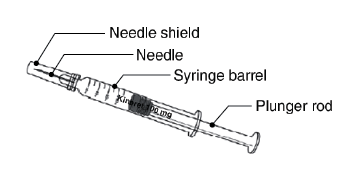
Use each KINERET graduated pre-filled syringe only once.
If you notice some solution remaining in the syringe, do not re-inject.
You should discard the syringe with any remaining solution in a puncture-proof sharps container.
If you drop the syringe, do not use the syringe. This is for your safety in case the syringe is broken or the needle is bent or dirty.
How to prepare your injection
Do not try to give yourself the injection if you or your carer have not been trained.
- Set up the materials needed for the injection:
- a new graduated pre-filled syringe of KINERET with attached needle
- alcohol swab
- a cotton ball.
- Take the box out of the refrigerator, and take one KINERET graduated pre-filled syringe from the box and put the remaining graduated pre-filled syringes back in the refrigerator.
- Do not shake the graduated pre-filled syringe.
If the solution is foamy, allow the graduated pre-filled syringe to sit for a few minutes until it clears.
- Check the expiry date (Exp.) on the graduated pre-filled syringe label. Do not use it if the date has passed.
- Check the appearance of KINERET. It must be a clear, colourless-to-white solution. It may contain some small translucent-to-white particles of protein. This is expected.
The solution should not be used if discoloured or cloudy or if there are clumps, large or coloured particles present.
Use a new graduated pre-filled syringe.
- For a more comfortable injection, take the graduated pre-filled syringe out of the fridge 30 minutes before you intend to use it or hold the graduated pre-filled syringe gently in your hand, warming it for a few minutes.
Do not warm KINERET in a microwave or in hot water or any other way.
- Do not remove the needle cover from the graduated pre-filled syringe until you are ready to inject.
- Wash your hands thoroughly with soap and water.
Selecting and preparing the injection
Find a comfortable, well-lit, clean, flat, hard surface and put everything you need within reach. Make sure you know what KINERET dose your doctor has prescribed: 20 to 90 mg, 100 mg, or higher.
- If your doctor has prescribed a 100 mg dose you should follow the "How to prepare a 100 mg dose" section;
- If your doctor has prescribed a lower dose you should follow the "How to prepare a 20 to 90 mg dose" section.
How to prepare a 100 mg dose
Before you inject KINERET you must do the following:
- Hold the syringe barrel and gently remove the cover from the needle without twisting. Pull straight as shown in Figure A. Do not touch the needle or push the plunger.
Discard the needle cover straight away.
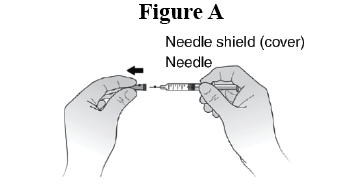
- You may notice a small air bubble in the graduated pre-filled syringe. You don't have to remove the air bubble before injecting. Injecting the solution with the air bubble is harmless.
- You can now use the pre-filled syringe as described in the "Where should you give your injection?" section and "How do you give your injection?" section.
How to prepare a 20 to 90 mg dose
Before you inject KINERET you must do the following:
- Hold the syringe barrel and gently remove the cover from the needle without twisting. Pull straight as shown in Figure A. Do not touch the needle or push the plunger. Discard the needle cover straight away.
- Turn the graduated pre-filled syringe so that the needle is now pointing straight upwards as shown in Figure B.
Put your thumb on the plunger rod and push slowly until you see a tiny liquid drop at the tip of the needle.
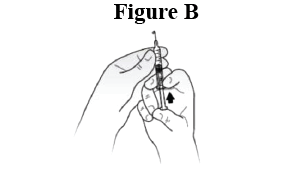
- Turn the syringe so that the needle is now pointing downwards. Place a sterile gauze or tissue on a flat surface and hold the syringe above it with the needle pointing towards the gauze or tissue, as shown in Figure C.
Make sure the needle does not touch the gauze or tissue.
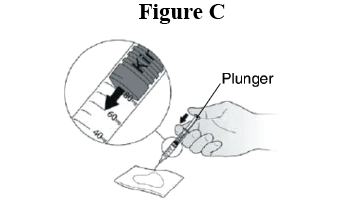
- Put your thumb on the plunger rod and push slowly until the front end of the plunger has reached the mark on the graduated scale of the recommended dose.
The extra liquid will be absorbed by the gauze or tissue as shown in Figure C.
- If you are not able to set the correct dose or if you drop the syringe, dispose of the syringe and use a new one.
- You can now use the graduated pre-filled syringe as described in the "Where should you give your injection?" section and the "How do you give your injection?" section.
Where should you give your injection?
The most suitable places to inject yourself or your child are (see Figure D):
- the abdomen (except for the area around the navel);
- the top of the thighs (this is especially good for infants under a year if they have slightly chubby legs);
- the upper outer areas of the buttocks; and
- the outer area of the upper arms.
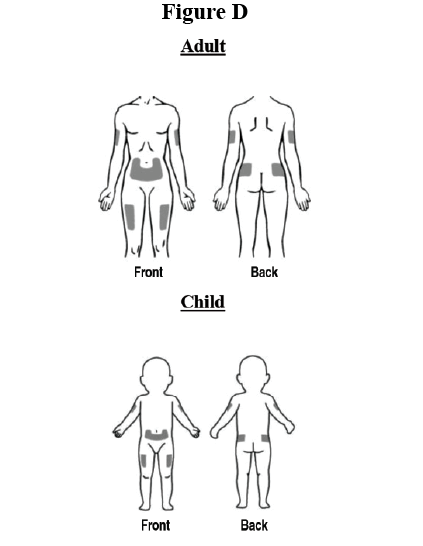
If someone is injecting for you, they can also use the back of your arms.
Change the place that you inject each time so you don't become sore in one area.
Do not inject into skin that is tender, red, bruised, or hard.
Avoid scars or stretch marks.
Don't inject close to a vein.
How do you give your injection?
- Disinfect the skin with the alcohol wipe and let it dry off naturally in the air (this only takes a few seconds). Then pinch the skin between your thumb and forefinger, without squeezing.
- Push the needle fully into the skin as shown by your nurse or doctor.
- Inject the liquid slowly and evenly, always keeping the skin pinched as in Figure E.
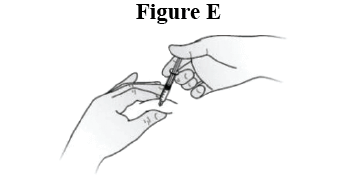
- After injecting the liquid, remove the needle and let go of the skin.
Only use each syringe for one injection. Do not reuse a syringe as this can cause infection. Any unused medicine must be discarded.
When to use it
Try to inject KINERET at approximately the same time each day on a schedule that works best for you. Taking it at the same time each day will have the best effect. It will also help you remember when to use it.
Schedule your KINERET injections with another task you do each day, such as getting dressed in the morning.
How long to use it
Continue using your medicine for as long as your doctor tells you.
The medicine helps control your condition, but it does not cure it. It is important to keep using your medicine even if you feel well.
If you forget to use it
If you have forgotten to use a dose of KINERET you should contact your doctor or nurse to discuss when you should use the next dose.
If you use too much (overdose)
Immediately telephone your doctor or the Poisons Information Centre on 13 11 26 (Australia) or 0800 764 766 (New Zealand) for advice, or go to Accident and Emergency at the nearest hospital, if you think that you or anyone else may have used too much KINERET. Do this even if there are no signs of discomfort or poisoning.
While you are using KINERET
Things you must do
Always follow your doctor's instructions carefully.
If you are about to be started on any new medicine, remind your doctor and pharmacist that you are using KINERET.
Tell any other doctors, dentists, and pharmacists who treat you that you are taking this medicine.
If you become pregnant while using this medicine, tell your doctor immediately.
Keep all of your doctor's appointments so that your progress can be checked. KINERET may cause a change in certain blood cells. Your doctor will arrange for blood tests before treatment and then periodically during treatment to monitor these changes.
Things you must not do
Do not use KINERET to treat any other complaints unless your doctor tells you to.
Do not give your medicine to anyone else, even if they have the same condition as you.
Do not use the KINERET graduated pre-filled syringe if it has been frozen.
Side effects
Tell your doctor or pharmacist as soon as possible if you do not feel well while you are using KINERET, even if you do not think the problems are connected with the medicine or are not listed in this leaflet.
All medicines can have side effects. Sometimes they are serious, most of the time they are not. You may need medical attention if you get some of the side effects. Other side effects are minor and are likely to be temporary.
Do not be alarmed by the following list of side effects. You may not experience any of them.
Ask your health professional to answer any questions you may have.
Tell your health professional if you notice any of the following and they worry you:
- headaches
- rash
- injection site reactions (ISRs).
ISRs are reactions that occur at the site where KINERET is injected. These reactions include redness, swelling, bruising, itching and pain at the injection site. It is not unusual to experience mild to moderate stinging or injection site reactions, especially when you are beginning therapy.
Most ISRs happen in the first 4 weeks of starting KINERET and usually resolve after about a month during continued use.
Helpful hints to manage injection site reactions:
- swelling - apply a cold pack to the injection site before and after injection
- itching - talk to your doctor or pharmacist. They may recommend a corticosteroid cream or antihistamine
- bruising - apply a cold pack to the injection site immediately after injection
- pain during and/or after injection:
- Try different injection locations. The stomach may be the best site due to the low number of nerve endings.
- Let the KINERET syringe warm to room temperature before injecting (30 minutes).
- Allow the alcohol at the injection site to dry before injecting KINERET.
Other side effects not listed above may also occur in some people. Some of these side effects can only be found when your doctor does tests from time to time to check your progress.
If any of the following happen, tell your doctor immediately or go to Accident and Emergency at your nearest hospital:
- a fever, a cough or redness and tenderness of the skin or other signs of infection
- swelling of the face, tongue or throat
- trouble swallowing
- itchy skin or rash
- shortness of breath or difficulty breathing
- wheezing
- suddenly feeling fast pulse or sweating.
The above list includes very serious side effects. You may need urgent medical attention or hospitalisation.
These side effects are very rare.
Tell your doctor or pharmacist if you notice anything that is making you feel unwell or worries you.
Other side effects not listed above may also occur in some people.
After using KINERET
Storage
Keep your KINERET graduated pre-filled syringes in the box until it is time to use them.
Keep your graduated pre-filled syringes in the refrigerator where the temperature stays between 2°C and 8°C.
You can leave KINERET out of the refrigerator but for no longer than a total of 12 hours at room temperature (up to 25°C).
Do not store KINERET in the freezer.
Do not let KINERET freeze.
Do not use KINERET after the expiry date, which is stamped on the box and syringe label.
Keep it where children cannot reach it.
Disposal
Do not put the cover back on used needles.
Put used syringes into a puncture-proof sharps container and keep it out of the reach and sight of children.
Close the lid of the full puncture-proof sharps container as instructed by your health professional. Contact your local council or the nearest hospital to find out where you can dispose of the sharps container.
Never put the used syringes into your normal household rubbish bin.
If you had a dose lower than 100 mg you will have ejected liquid from the syringe onto a gauze or tissue. Discard the wet gauze or tissue into the sharps container and clean the surface with a fresh tissue.
The needle cover, alcohol swabs and other used supplies can be thrown out with your normal household rubbish.
Product description
What it looks like
KINERET is supplied in single use graduated pre-filled syringes as a sterile, clear, colourless-to-white, preservative-free solution for subcutaneous administration.
The solution may contain some small translucent-to-white particles of protein.
KINERET is available in packs of 28 syringes.
Ingredients
Each KINERET syringe contains 100 mg of the active ingredient anakinra (100 mg / 0.67 mL).
Other ingredients:
- sodium citrate dihydrate
- sodium chloride
- disodium edetate
- polysorbate 80
- water for injections.
Supplier
KINERET is supplied in Australia by:
Swedish Orphan Biovitrum Pty Ltd
Floor 22, 44 Market Street
Sydney NSW 2000
® = Registered Trademark of Swedish Orphan Biovitrum AB (publ).
Australian Registration Number: AUST R 82872
This leaflet was revised in August 2021.
For the most up to date version of this leaflet, please go to https://au.sobi.com
Published by MIMS October 2021
